Castles in Aberdeen & Aberdeenshire
There are over 200 castles in Aberdeenshire.Castles set in the stunning landscape of the North East. There are more castles in Aberdeenshire per acre than anywhere else in the British Isles.
The North East of Scotland had strategic importance across centuries of turbulent history – invasions and war, rebellion and uprising, independence and occupation were all played out here. The evidence is in the remains of Iron Age hillforts, in ancient clifftop ruins, medieval fortresses, Scottish baronial castles, Jacobean mansions, and fortifications added in the 18th century.
In the centuries since, these often-extraordinary buildings have inspired famous storytellers such as Robert Louis Stevenson, Bram Stoker, Walt Disney and Franco Zeffirelli. Of course, Aberdeenshire’s most famous castle is Balmoral – the summer residence of the Royal Family since the 19th century, described by Queen Victoria as “my dear paradise in the Highlands”.
Aberdeen
Aberdeen Castle
No remains left, situated on Castle Hill, a site today known as the Castlegate, where a block of flats is currently located. It is thought the castle and fortifications were burned down by King Robert the Bruce in June 1308, during the Wars of Scottish Independence. Bruce and his men laid siege to the castle before massacring the English Garrison to prevent its use by the English troops of Edward II
Your linkAberdeenshire

Abergeldie Castle
Situated near Crathie, Abergeldie Castle was built by Sir Alexander Gordon of Midmar around 1550, though the estate had been held by the Gordons since 1482. During the first Jacobite rising in 1689, the castle was occupied by Spanish troops under the command of General Hugh Mackay. Still standing, the castle is said to be haunted by a ghost by the name of either French Kate, or Kitty Rankie. She was a French woman who was reportedly employed at the castle, but was ultimately accused of witchcraft. The lady was confined in the castle before being burned at the stake on a nearby hill.
Your link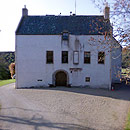
Allardice Castle
Part of a chain of coastal Castles, Allardice Castle (also spelled Allardyce) is a sixteenth-century manor house in Kincardineshire. This monument is resided in by the Cowie family and is situated approximately 1.5 kilometres northwest of the town of Inverbervie. The Bervie Water flows near to Allardice Castle.
Banff Castle
Located near Banff in the far north of Aberdeenshire, Banff Castle was a former royal castle, which is now ruined. It was initially built as a motte and bailey castle sometime in the 1100s, and was held by the Comyn Earls of Buchan. The castle was garrisoned by the English, and was twice visited by their king Edward I – in 1296, and again in 1298 after the defeat of William Wallace at the Battle of Falkirk. In 1310, however, Scottish forces retook the castle. Over the centuries the castle passed between a number of different families, before eventually being destroyed and replaced with a mansion house in 1750 that had been designed by the architect John Adam.

Balmoral Castle
Balmoral Castle is one of the most famous castles in Scotland, and has been a residence of the British Royal family since 1852. However, the Balmoral estate had a royal connection as long back as the 14th century where Robert II of Scotland had a hunting lodge. A number of different families, including the Drummonds, Gordons, Farquharsons, and Duffs, have all owned the Balmoral estates at some point, but it was eventually purchased privately by Prince Albert, husband of Queen Victoria, in 1852. The royal family found that the then Balmoral Castle was too small, and so decided to build a new one. The current Balmoral Castle is a Scots Baronial mansion and was completed in 1856. Its architect was William Smith, who was directed by Prince Albert himself. After the completion of the castle, the old one was soon destroyed.

Balquhain Castle
Balquhain Castle, a ruinous tower house just west of Inverurie, was built by Clan Leslie sometime in the early to middle of the 1300s. The castle, however, was sacked by the Forbes’ during a feud in 1526, and was rebuilt in 1530. The night before the 1562 Battle of Corrichie, Mary, Queen of Scots, spent the night at Balquhain before seeing her forces defeat those of the Gordons of Huntly. In the aftermath of the 1745 Jacobite uprising, Balquhain Castle was razed by the forces of the Duke of Cumberland in 1746 and was abandoned and never restored.
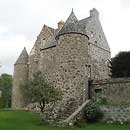
Barra Castle
A castle on this site was, from the mid-13th century, the seat of the King family. Barra Castle is an unusual L-plan tower house, dating from the early 16th century, about two miles south of Oldmeldrum, above the Lochter Burn, in the parish of Bourtie, Aberdeenshire, Scotland. It occupies the site of the battle in which Robert Bruce defeated John Comyn, Earl of Buchan
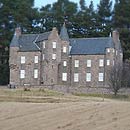
Birse Castle
Near Aboyne, Birse Castle is a mansion house which incorporates an older tower house. It was held by the Bishop of Aberdeen, but passed to the Gordons of Cluny. The castle was sacked by neighbours in 1640, annoyed by the Gordons’ continuous encroachment into their lands. In the 1740s the castle was a haven for outlaws before eventually becoming ruinous. Birse was rebuilt into its current L-plan structure in 1911, and is currently occupied.

Bognie Castle
Also known as Conzie Castle, Bognie Castle stands ruined near Huntly, in the north of Aberdeenshire. An earlier castle was held by the Dunbars of Conzie in the 15th and 16th centuries, and it is believed that the current remains are from a castle built by Clan Morrison sometime in the 1600s.

Braemar Castle
The current Braemar Castle was built by John Erskine, 18th Earl of Mar, in 1628, though, there had been a previous castle on the estate. Erskine built the castle in a hope to curb the rising power of the neighbouring Clan Farquharson. During the first Jacobite uprising, the Black Colonel of Inverey, John Farquharson, attacked the castle in 1689 and burned it, attempting to prevent it falling into the hands of the Government’s forces. However, in 1716, the stronghold was forfeited to the State due to the 23rd Earl of Mar’s leadership in the 1715 Jacobite uprising. The castle was then purchased by John Farquharson, 9th Laird of Invercauld, but it remained in ruin until 1748 when he leased it to the government for £14 per year, and it was to serve as a garrison for Hanoverian troops. The government gave up the lease in 1831, and so Braemar Castle was returned to the Farquharsons, and further restoration was done to create a family home. Queen Victoria was entertained at the castle when she traveled north for the Braemar Gatherings, which were held on the castles’ grounds. Today, the castle is open to the public, and has been leased out to a local community charity who look after the castle by the chief of Clan Farquharson
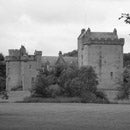
Cairnbulg Castle
Located in the far north-east of Aberdeenshire, Cairnbulg Castle, previously known as Philorth Castle, was built sometime in the early 1300s, but was destroyed not long after during the winter of 1308-09 in the Wars of Independence. The Frasers rebuilt the caste in 1380, adding outbuildings and courtyard to the original main tower. The castle is open to the public, but it is also still occupied by Clan Fraser. Cairnbulg was home to the clan chief, Flora Fraser, 21st Lady Saltoun, and her late husband Captain Alexander Ramsay of Mar, who was a great-grandchild of Queen Victoria, but is now occupied by their daughter Katherine Fraser, Mistress of Saltoun.
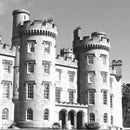
Cluny Castle
The current Cluny Castle was built around 1604, replacing a previous structure. Over the centuries, the castle, just to the west of Aberdeen, has been owned by three different branches of the Gordon family. Sometime before 1325 Robert the Bruce granted the lands of Cluny to his brother-in-law, Alexander Fraser. Going down through the family, the lands were passed to John Gordon, a son of the 3rd Earl of Huntly. It was John’s son, Sir Thomas Gordon, who began building the small castle that eventually transformed in the 19th century into the crenellated mansion that stands today.

Corgarff Castle
Located in the pass between Strathdon and Tomintoul in west Aberdeenshire, Corgarff Castle, a tall tower house, was built by the Forbes of Towie sometime in the middle part of the 1500s. During a long running feud with the Gordons, Adam Gordon of Auchindoun and band of his men laid siege to Corgarff in 1571. The Forbes men were all away from the castle at the time, and the only occupants were Lady Margaret Campbell, the wife of Forbes of Towie, along with twenty six other women, children, and servants. Lady Forbes refused to surrender the castle, and even shot one of Gordon’s men in the knee. Growing impatient, Adam Gordon decided to torch the castle, which resulted in everyone inside being killed. The victims of this massacre are said to still haunt the castle to this day. During the Jacobite risings the castle was torched at least another two times, and was rebuilt after 1746 and used as a barracks for government troops. It was in use by the military up to 1831, afterwards it served as a distillery and housed the local workers. Corgarff Castle today is in the hands and care of Historic Scotland and is open to the public.

Craigievar Castle
The distinctive pinkish Craigievar Castle lies six miles south of Alford in the heart of Aberdeenshire. The castle is a seven-storey L-plan tower house, and was completed in 1626. Craigievar was initially started by the Mortimer family, but they became financially poor, and Aberdeen merchant William Forbes bought the estate in 1610 and went on to complete the structure. William Forbes was said to have been a zealous Covenanter who also fought in the Civil War, as well as having been the Sheriff of Aberdeen. The Forbes family resided at Craigievar for nearly 360 years, when in 1963 it passed on to the National Trust for Scotland who take care of the castle.
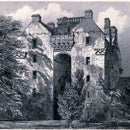
Craigston Castle
Built between 1604 and 1607, Craigston Castle near Turiff in north-east Aberdeenshire, is a historic home of Clan Urquhart. The estate was initially held by the Craigs, but passed to the Urquharts, and it was John Urquhart of Craigfintry who built the castle. One of the Urquhart family members, Captain John Urquhart (b. 1696), known as ‘The Pirate’, is suspected to have amassed his fortune from captured ships when he served in the Spanish Navy. He also narrowly escaped death whilst fighting for the Jacobites at the 1715 Battle of Sheriffmuir. Captain Urquhart modified the castle in 1733, commissioning renowned architect William Adam to design the wings that were added. One hundred and five years later another eminent architect, John Smith, who went on to build Balmoral Castle, designed a new entrance doorway. Craigston Castle is still, to this day in the Urquhart family.
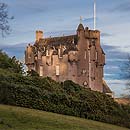
Crathes Castle
Crathes Castle is a 16th-century castle near Banchory in the Aberdeenshire region of Scotland. This harled castle was built by the Burnetts of Leys and was held in that family for almost 400 years. The former home of the Burnett family.

Delgatie Castle
Delgatie Castle stands some two miles east of Turriff in Aberdeenshire. Delgatie Castle is very much the product of decades of hard work and dedication by the late Captain John Hay of Delgatie. The building he purchased in the early 1950s was effectively a derelict ruin after decades of infestation by dry rot and its use as a temporary barracks for troops returning from Dunkirk early in the war. Captain Hay and his wife Everild set out to restore the castle to a comfortable home. And having returned Delgatie Castle to Hay family ownership after a gap of nearly two centuries, Captain Hay went on to establish the Clan Hay Centre here. He first opened the castle to the public in 1994.

Drum Castle
Drum Castle is a castle near Drumoak in Aberdeenshire, Scotland. For centuries it was the seat of the chief of Clan Irvine. The place-name Drum is derived from Gaelic druim, ‘ridge’.

Drumtochty Castle
Drumtochty Castle is a neo-gothic style castellated mansion erected in the year 1812 approximately three kilometres northwest of Auchenblae.
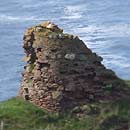
Dundarg Castle
Dundarg Castle is a ruined castle about 2 kilometres (1.2 mi) north-northeast of New Aberdour. It was built in the thirteenth century by the Comyn family, and subsequently dismantled, probably by Robert the Bruce, in 1308. It was rebuilt in 1334 by Henry de Beaumont, but destroyed almost immediately, after a famous siege by Sir Andrew Moray. Evidence of this double destruction was confirmed by excavations during 1911-12 and in 1950-51 (led by W. Douglas Simpson) when many medieval objects were found. The only substantial part of the castle remaining is the inner gatehouse, which survives to a height of about 18 feet (5.5 m). The upper part was rebuilt about the middle of the sixteenth century, probably following the Coastal Defence Commission of 1550, and there is some evidence that it was provided with gunloops at this time. The site was finally abandoned in the mid-17th century, and a house was built on part of it in 1938.
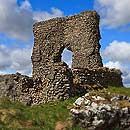
Dunnideer Castle
Dunnideer Castle, now ruined, was a tower house located near Insch, Aberdeenshire, Scotland. It was built c.1260 partially from the remains of an existing vitrified hill fort in the same location. It consisted of a single rectangular tower of 15m by 12.5m with walls 1.9m thick. Evidence suggests that a first-floor hall existed. Evidence Shows it Had several floors. The tower house is built within an older prehistoric vitrified hillfort dating to c250 BC.

Dunnottar Castle
A romantic, evocative and historically significant ruined Castle, perched on a giant conglomorate on the edge of the North-Sea. An impregnable fortress that holds many rich secrets of Scotland’s colourful past. The dramatic and evocative ruined cliff top fortress was the home of the Earls Marischal, once one of the most powerful families in the land. William Wallace, Mary Queen of Scots, the Marquis of Montrose and the future King Charles II have graced the Castle with their presence. Most famously though, it was at Dunnottar Castle that a small garrison held out against the might of Cromwell’s army for eight months and saved the Scottish Crown Jewels, the ‘Honours of Scotland’, from destruction.
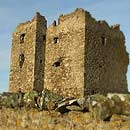
Eden Castle
Eden Castle is a castle near Banff in Aberdeenshire, Scotland. The castle was built in the latter half of the 16th century by the Meldrum family with renovation and additional building carried out by George Leslie from 1676.
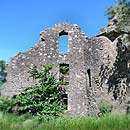
Esslemont Castle
Esslemont Castle is in the parish of Ellon. The first mention of Esslemont is as the ‘manor of Eislemont’ in the 14th century. The lands of Esslemont were passed by marriage from the family of Mareschal to the Cheynes of Straloch in the 14th century. After the castle was burnt in 1493, Henry Cheyne undertook re-building via a king’s licence dated 1500. In 1564 Patrick Cheyne was created baron of Esslemont by Queen Mary, who stayed here during her campaign against the Earl of Huntly, and a fortalice and tower were recorded in 1575–6. The castle was then destroyed as the result of a feud between the Cheynes and the Hays. The name of the lands, now as “Essilmounthe”, appears in Scottish records in 1609. The castle ceased to be regularly occupied in 1625, when the estate passed to the Errol family. In 1728 it became the property of Robert Gordon and may have been partially occupied till 1769, when the existing mansion, Esslemont House, was erected in its vicinity.
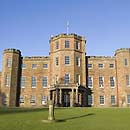
Fasque Castle
Fasque, also known as Fasque House, is a mansion in Aberdeenshire, Scotland, situated near the village of Fettercairn, in the former county of Kincardineshire. Fasque was the property of the Ramsays of Balmain, and the present house was completed around 1809, replacing an earlier house. It was purchased in 1829 by Sir John Gladstone, 1st Baronet, father of William Ewart Gladstone, Prime Minister to Queen Victoria, who spent much of his childhood here. Fasque was a family home of the Gladstones until the 1930s, and was open to the public during the last quarter of the 20th century. In 2010 Fasque House was bought by Fasque House Properties Ltd and restoration work was begun.
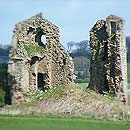
Fedderate Castle
Fedderate Castle is a ruined castle near New Deer in Aberdeenshire, Scotland. A drawbridge and causeway provided access to the castle. Lord William Oliphant with Jacobite forces, took control of Fedderate Castle and held out against the forces of Hugh Mackay for more than 3 weeks, surrendering in October 1690.

Fetteresso Castle
Fetteresso Castle is a 14th-century towerhouse, rebuilt in 1761 as a Scottish gothic style Palladian manor, with clear evidence of prehistoric use of the site. It is situated immediately west of the town of Stonehaven in Kincardineshire slightly to the west of the A90 dual carriageway. Other notable historic fortified houses or castles in this region are Dunnottar Castle, Muchalls Castle, Fiddes Castle, Cowie Castle and Monboddo House.

Findlater Castle
Findlater Castle sits in a romantic position on a 50-foot (15 m)-high cliff overlooking the Moray Firth on the coast of Banff and Buchan. It is just under 10 miles west of Banff, near the village of Sandend. The castle is on a cliff with a drop of over 50 feet to the sea. The castle was probably built by Sir John Sinclair of Findlater, who died in 1411 at the battle of Harlaw. The castle is clearly modeled on Roslin Castle, which was the principal stronghold of the Sinclair family.The castle is now in ruins. Earliest records of the castle date back to 1246. King Alexander III of Scotland repaired the castle in the 1260s in preparation for an invasion by King Haakon IV of Norway. The Vikings captured the castle for some time. The castle was redesigned and rebuilt in the 14th-century.

Castle Forbes
The Castle Forbes Estate in Aberdeenshire is the seat of the Chief of the Forbes Clan. The lands were granted to Sir Alexander Forbes (later the 1st Lord Forbes) in 1411 for his part in the defeat of Donald of the Isles at the battle of Harlaw.
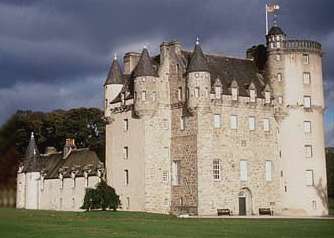
Castle Fraser
Castle Fraser is the most elaborate Z-plan castle in Scotland and one of the grandest ‘Castles of Mar’. It is located near Kemnay in the Aberdeenshire region of Scotland. Built between 1575 and 1636 by the 6th laird, Michael Fraser, Castle Fraser is the most elaborate Z-plan castle in Scotland. The castle belongs to the same period of native architectural achievement as two neighbouring castles, Crathes and Craigievar. Castle Fraser retains the atmosphere of a family home and still contains the original contents, including Fraser family portraits, furniture and collections. The evocative interiors represent all periods of the castle’s history, from the Medieval stone vaulted Great Hall to the Regency Dining Room and even Charles Mackenzie Fraser’s wooden leg!
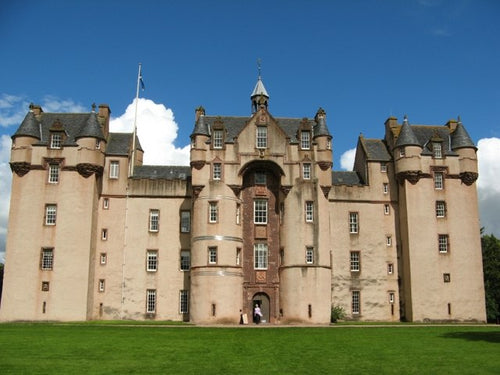
Fyvie Castle
This stunning castle was once a royal stronghold, one of a chain of fortresses throughout medieval Scotland. The oldest part of the castle still stands today, dating from the 13th century, which houses a great wheel staircase, the finest in Scotland. Contemporary panelling and plaster ceilings survive in the 17th-century Morning Room and the opulence of the Edwardian era is reflected in the interiors created by the first Lord Leith of Fyvie. A rich portrait collection is also found in the castle including works by Batoni, Raeburn and Hoppner; and there is a fine collection of arms and armour and 17th-century tapestries. The grounds and loch were designed as landscaped parkland in the early 19th century. The 18th-century walled garden has been redeveloped as a celebration of Scottish fruits and vegetables. Visitors can also enjoy the restored racquets court, ice house, bird hide, restored earth closet and beautiful loch-side walks.

Hatton Castle
Hatton Castle is situated almost 3 miles (4.8 km) south-east of Turriff, Aberdeenshire in the north east of Scotland. Formerly known as Balquholly Castle, sometimes spelt as Balquollie, it was re-named in 1814. It was designated a category A listed building by Historic Scotland on 28 November 1972. The gardens are included on the Inventory of Gardens and Designed Landscapes in Scotland and assessed under the historical and architectural sections as outstanding. In the early fourteenth-century, Robert the Bruce granted the lands, then known as Loscraigie, to Patrick de Monte Alto. Mowat is the anglicisation of de Monte Alto. The Balquholly name was adopted some time before the 16th-century. Records indicate there was a castle (spelt Balquholy) on the lands in the early 1500s but it is likely it may have an earlier date. The present castellated mansion was built starting in 1812 and completed by 1814; it was at this time the name was changed to Hatton Castle. It features a round tower at each corner and incorporates sections of the ancient building.

Glenbuchat Castle
Glenbuchat Castle is an historic Scottish castle located above the River Don, near Kildrummy, Aberdeenshire. The building is roofless, but otherwise in fairly good repair. Both the castle and the surrounding land are now managed by Historic Scotland. Glenbuchat was built in 1590 as a new residence for John Gordon of Cairburrow and his second wife, Helen Carnegie, to mark their wedding. The Gordon family sold the castle in 1738, by which time it was already partly unroofed by that time. The castle was bought by James Barclay, MP, in 1901 and he carried out essential repairs to conserve the ruin. In 1946 he handed the castle over to the state.

Huntly Castle
Huntly Castle lies in the green heart of the Aberdeenshire countryside. It is a noble ruin in a beautiful setting, remarkable both for the quality of its architecture and for its eventful history. The earls of Fife built the original stronghold, the Peel of Strathbogie, around 1190, to guard the crossing-point where the rivers Bogie and Deveron meet. But it was the mighty Gordons who made the stronghold their own from the 14th century and renamed it Huntly Castle. The surviving remains tell the story of the development of the castle in Scotland, from the motte and bailey of the 12th century, through the tower house of the later Middle Ages, to the stately stone palace of the Jacobean era.

Inchdrewer Castle
Inchdrewer Castle is a Grade A listed 16th Century Castle and is believed to have been built in the early to mid 1500’s and was purchased by Sir Walter Ogilvie of Dunlugas (or his son, Sir George) in 1557 from the Curror family. A successor, Lord Banff, lived there in 1642 until killed by a fire in the castle in 1713. The castle has a long and interesting history with many historical mentions including the attack on Inchdrewer by the Duke of Cumberland in 1746 when hunting for Bonnie Prince Charlie. It is also understood that the castle was visited by King Edward VII and the Duke of Fife in its past. The castle was abandoned in the early 1900’s and then bought by the current owners family in 1963 when it was found to be in a mainly ruinous state. Together with a local firm of family builders the castle was restored to a wind and water tight condition by 1971.

Inverallochy Castle
Inverallochy Castle is a ruined castle near the village of Inverallochy in the Buchan area of north-east Scotland. It was described by W. Douglas Simpson as one of the nine castles of the Knuckle, referring to the rocky headland of north-east Aberdeenshire.[1] The ruins lie a half-mile south of Cairnbulg Castle near Fraserburgh. Walls surrounding an inner courtyard remain, along with one partly collapsed tower. Evidence of a larger outer courtyard measuring approximately 60 metres square to the north and east remains. The original castle dates to the 13th century. It was built by the Comyn family, and may have been associated with the Abbey of Deer in Mintlaw.

Invercauld Castle
Invercauld Castle is a country house situated in Royal Deeside near Braemar in Scotland. It is protected as a category A listed building, and the grounds are included in the Inventory of Gardens and Designed Landscapes in Scotland. The Farquharson family settled in the area in the 14th century, and constructed a tower house in the 16th century. A vaulted basement within the present building dates from this time, although the tower house was remodelled in the late 17th century. Further alterations were made through the 18th and 19th centuries, and in 1875 the castle was extensively remodelled by John Thomas Wimperis in the Scots Baronial style. The house retains many Victorian furnishing and paintings.

Inverugie Castle
Located two miles from Peterhead on the north east coast.The ruins are a small mound only three metres high above the River Ugie. This is all that remains of a wooden motte-and-bailey castle of Inverugie built by the Cheynne family in the 12th century. The stone ruins date from later than the original building on the site. The castle of Inverugie was first raised by the Cheyne family in the 12th century. By the mid-14th century the estate of Inverugie had passed to the Keith Earl Marischals who had their main seat at the coastal fortress of Dunnottar Castle. They built the current (ruined) stone castle of Inverugie south of the original wooden motte in around 1660. In the 19th century an oak heraldry shield was found in a local cottage with the arms of William Keith, 7th Earl Marischal and its date was carved as 1660. The Keith lands were forfeited after the Jacobite Rebellion and some time after 1745 the Inverugie estate passed from the Keiths to one James Ferguson the third Laird of Pitfour who kept the building in a perfect state until he died in 1820. However, the fifth Laird stripped the Castle of all the restoration undertaken and his successor exacerbated the neglect even further. By 1890, the Castle was in poor condition and was unable to withstand inclement weather. Gales in April 1890 resulted in the collapse of some walls and the stair tower. It was declared unsafe by the Local Authority following further storms on New Years Day 1899. The estate factor, William Ainslie, probably acting under instruction from the Laird at that time, arranged to have much of what was left of the ruins blown up, weakening the remaining structure. Within a fortnight, little remained of the castle. Charles McKean described the castle as “a splendid double-courtyard Renaissance chateau” and also said “It consisted of a four-storey block with circular angle towers and a stair turret”.

Kildrummy Castle
Kildrummy Castle was once one of the most magnificent and imposing castles in Scotland. It was built in about 1250 by the Earl of Mar. The castle was intended to consolidate the Mar dynasty’s hold over north-eastern Scotland and was located where it could command important routes across the region. The estate passed to the Elphinstone family in 1507.
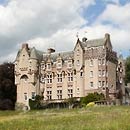
Kincardine Castle
Kincardine Castle is a Victorian country house in Royal Deeside, Scotland. It is 1 kilometre (0.62 mi) north-east of the village of Kincardine O’Neil, and 8 kilometres (5.0 mi) east of Aboyne on the north side of the River Dee, Aberdeenshire. The castle was built in 1894-6 to Scots Baronial designs by Niven and Wigglesworth of London. The architects were influenced by the Arts and Crafts movement and this shows in the design. It is a category B listed building. The house was built on the site of, and incorporating part of, an earlier building called Kincardine Lodge, dating from around 1780. T. H. Mawson prepared plans for the gardens around 1900, though it is not clear if they were carried out. At the heart of a 3,000-acre (1,200 ha) estate, the castle is not open to the public, but serves as a venue for meetings, private dining, marquee events and weddings. There are extensive gardens which are open for one day in June under the Scotland’s Gardens scheme.

Kinnairdy Castle
Kinnairdy Castle is situated in the Deveron Valley at Bridge of Marnoch, between Turriff and Keith, Aberdeenshire. It is tower house dating back to the 14th century, originally built by the Innes family. The castle is owned again by the Innes family. The castle consists of a stone tower which dates to around the 14th century and a Palace, built in the 16th century. The Palace was renovated recently with work completed in 2002. Kinnairdy is available as self catering accommodation for up to eight people. Kinnairdy Castle is owned by Colin Innes, Baron of Aberchirder, and is looked after by a resident caretaker. Viewings are strictly by prior arrangement. The present castle replaced a wooden motte and bailey structure in the 14th century. During the latter part of the 14 century Kinnairdy came into the ownership of the Innes family. In 1627 Sir Robert Innes, the 20th chief, sold Kinnairdy to Sir James Crichton of Frendraught. In the 17th century it was taken over by the Gregory family, although the change of hands involved a legal dispute and murder of one of the Gregory sons. Kinnairdy Castle was the 17th century home of the Gregory family, an academic family that produced 12 professors including David Gregory, the inventor of the barometer. In 1704 the Gregory family sold the Castle to Thomas Donaldson, a merchant in Elgin, who transformed Kinnairdy from a mediaeval fortress to a 17th century style country house. Sir Thomas Innes of Learney, (Lord Lyon King of Arms 1945 – 69) bought it in 1923.
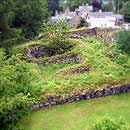
Kindrochit Castle
Kindrochit Castle is in ruins, right in the center of Braemar village in Royal Deeside. In an area that is known for beautiful castles like Braemar and Balmoral, one visits Kindrochit to pay homage to the first castle to be built in the village. Some of the walls are still standing, the rest have been used for other buildings or removed to build roads. The district was known as the Parish of St. Andrew, later changed to Kindrochit, and now Braemar. Kindrochit Castle was built between 1057 and 1093 by King Malcolm III, King of Scotland. The castle was then named Ceann-drochit meaning Bridge Head. A bridge was built here across the River Clunie which was the only means to cross it for several miles. It is believed that King Robert II spent time here to enjoy the hunting on the Braes of Mar. Subsequently King Robert III gifted the castle to Sir Malcolm Drummond, his brother-in-law. He built the family tower on the site in 1390, making it the fifth largest castle in Scotland at the time.

Knock Castle
Situated on the south side of the River Dee, just to the west of Ballater, are the ruins of Knock Castle, a 16th century four-storey tower house built for the Gordon family. The castle, now in the care of Historic Scotland has a dark history. At one time seven sons of Alexander Gordon, the 3rd Laird of Knock, were murdered by a neighbouring rival clan the Forbes. Upon receiving the news of his sons deaths the 3rd Laird collapsed and died himself. The Forbes laird was subsequently executed and all his lands forfeited.
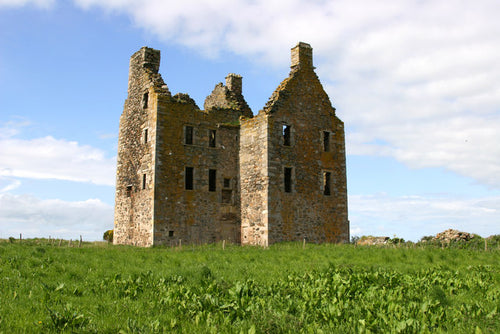
Knockhall Castle
Knockhall Castle is situated a the mouth of the River Ythan near Newburgh in Aberdeenshire. It was built by Lord Sinclair of Newburgh in 1565. The Udny clan bought the castle in 1634. The building captured by Earl Marischal for the Covenanters, in 1639 and damaged in the process. It later returned to Udny clan who remained in the castle until 1734 when fire destroyed Knockhall. After the fire, the family moved to their other property, Udny Castle. Knockhall Castle is now in ruins
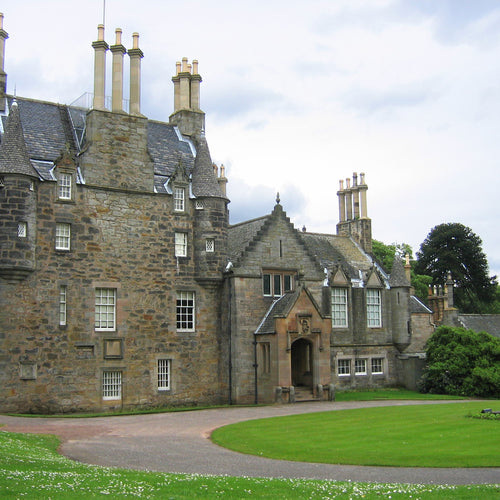
Lauriston Castle
Lauriston Castle stands on a clifftop site near the Aberdeenshire village of St Cyrus and just over a mile inland from the North Sea coast of Scotland. Once a royal fortress, it can claim to be one of the oldest privately owned and inhabited castles in the region. By tradition, it was the stronghold of Giric, Grig or Gregory the Great, one of the last of the Pictish kings (AD 878–889). The site of his church of Ecclesgreig (Eglise Grig) is nearby and he gave his Latin name, Ciricius, to St.Cyrus. Lauriston’s first charter is dated 1243 and it soon developed into a classic courtyard castle which was savagely fought over during Scotland’s Wars of Independence and strengthened by King Edward III in 1336 as part of the chain of Plantagenet strongholds which he hoped would prevent a French landing in support of the Scots. One of the corner towers on the edge of the cliff was incorporated into a typical laird’s house in the 1500s. In turn, this house was absorbed into a very large Georgian mansion of Palladian design, dated 1765–89. For nearly 450 years Lauriston was held by the Stratons, whose arms of 1292 are among the earliest recorded in Scotland. The eloquent Declaration of Arbroath, the famous letter of 1320 to Pope John XXII, sealed by the nation’s earls and barons, has as its final signatory the name of Alexander Straton.
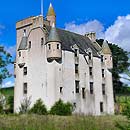
Leslie Castle
Near to Leslie, Aberdeenshire, Scotland Recently rebuilt in Scottish Baronial style, Leslie Castle lies north-west of Bennachie. For a short period, Leslie Castle was a private hotel but the hotel business closed in the 1990s.
Lonmay Castle
The remains of the Castle of Lonmay are found near Netherton of Lonmay, to the … of the Knuckle, referring to the rocky headland of north-east Aberdeenshire. The remains are found “in the Links”.. “near the sea” however “all the stones have been carried off, and employed in building farm-houses” and so “except the name, all tradition respecting this building is lost”
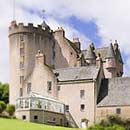
Midmar Castle
Midmar Castle is situated north of the Hill of Fare, 3 miles west of Echt in Aberdeenshire. the castle was completed around 1570 by the Gordons of Grampian. Midmar Castle is a Z-plan tower with a square tower at one end and a flat-topped round tower at the opposite end. The castle is made up of three separate blocks – the 16th Z-house, an 18th-century L-shaped east wing and a long rectangular west wing enclosing an entrance terrace and forecourt. The Z-house has a central block of five floors, a circular tower of six floors to the south-east and a square tower of five floors containing the main stairs to the north-west. The circular tower is flat topped with a castellated parapet, the main block has a steeply pitched and slated roof, with corbelled square corner turrets at the north-east and south-west corners. The square tower has a pitched roof with corbelled rounds. The chimneys are coped and the gables crow-stepped. There is a stone circle from the 3rd millennium BC in the graveyard of the church.

Muchalls Castle
Muchalls Castle stands overlooking the North Sea in the countryside of Kincardine and Mearns, Aberdeenshire, Scotland. The lower course is a well preserved Romanesque, double-groined 13th century towerhouse structure, built by the Frasers of Muchalls. Upon this structure, the 17th-century castle was begun by Alexander Burnett of Leys and completed by his son, Sir Thomas Burnett, 1st Baronet, in 1627. The Burnetts of Leys built the remaining four storey present day castle. One of the most interesting castles of northeast Scotland, according to noted architectural historian Nigel Tranter, it is designed in the classic L style with a further extension wing at the west end. Muchalls Castle entered national history in 1638 when a seminal Covenanter gathering took place here precedent to the English Civil War.

Castle Newe
Castle Newe was a castellated mansion house, situated in Aberdeenshire, and built in 1831 by Archibald Simpson. It was based on an existing Z-plan castle from 1604, which had square towers and was similar to Glenbuchat Castle. The castle was demolished in 1927 and the stone used to build Elphinstone Hall, University of Aberdeen. The former coach house is now known as the House of Newe, and contains furniture from the castle. It was a property of the Clan Forbes.

Castle of Park
A romantic 16th century pink castle, hidden away in a tree lined park, close to the beautiful Banffshire Coast, home of the Campbell Wilson family.
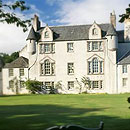
Peill Castle (Leith Hall)
Leith Hall was built around 1650 by James Leith of New Leslie on the site of the much older Peill Castle. Additions were made in the 18th and 19th centuries. Leith Hall was handed to the National Trust for Scotland in 1945 by Mrs Leith-Hay.
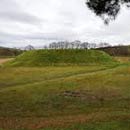
Peel of Lumphanan (Lumphanan Castle
Lumphanan Castle itself was built by the Durward family who were important members of the Court of de Lundis – a Norman family who had settled in Angus around the late twelfth century. The Durwood’s established their principle seat at Coull where they built a stone castle but they also constructed Lumphanan at this time – most probably as a hunting lodge. The fortification consisted on a natural mound, heightened by additional earthworks, topped by a timber palisade (hence the name ‘Peel Ring’). Surrounding the mound were two circular flooded ditches. A sluice controlled the water level and a drawbridge provided access into the interior. The castle was still occupied in the late thirteenth century when, in July 1296, it hosted a visit by Edward I in order for Sir John de Melville, Lord of Raith to render his homage to the English King. Shortly after this event the castle was abandoned.
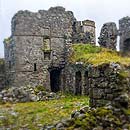
Pitsligo Castle
An imposing ruin of an early 15th century tower house, Pitsligo was built around 1424 by the Fraser family of Philorth. Ownership later passed to the Forbes family of Druminnor, and it was they who extended the castle to roughly its current layout. In 1633 Alexander, the 8th laird, was named Lord Fobes of Pitsligo by an Act of Pariament. Lord Forbes built the nearby kirk, with a wonderful laird’s loft over a family burial vault. In 1635 he turned his attention to the castle, greatly enlarging the medieval tower with ranges of buildings around a courtyard. The 2nd Lord finished his father’s work, creating a luxurious residence with opulent interiors. Every window was glazed – a measure of just how much wealth the laird lavished on his new home, with becae one of the finest residences in north-east Scotland.

Pittulie Castle
Pittulie Castle is a late 16th century fortified house just outside Rosehearty, on the north Aberdeenshire coast. We don’t know exactly when it was built, but it was likely erected in 1596 to celebrate the marriage of Alexander Fraser of Philorth to Margaret Abernethy of Saltoun. From the Frasers the castle eventually passed to the Cumine family, who expanded the original tower. Sometime prior to 1791 it was acquired by Sir William Forbes, but it was finally abandoned around 1850 and left to moulder away.
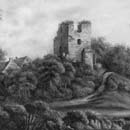
Castle of Rattray
**note there is also a castle Ratray in Perthshire** The Castle of Rattray was a medieval Scottish castle, with multiple variations on its structure over approximately six centuries. Originally built as a “late 12th- or early 13th century defensive motte” it provided protection for Starny Keppie harbour and Rattray village. Sometime between 1214 and 1233 it was upgraded by William Comyn, jure uxoris Earl of Buchan before being destroyed in the 1308 Harrying of Buchan. After Comyn’s timber castle was burned down it was replaced by a stronger stone castle which was engulfed during a 1720 sand storm along with nearby Rattray village. After the storm, the castle was not dug out and remains covered to this day. The castle was described by W. Douglas Simpson as one of the nine castles of the Knuckle, referring to the rocky headland of north-east Aberdeenshire

Ravenscraig Castle
Ravenscraig Castle or the Craig of Inverugie as it was more anciently called, stands on the south bank of the River Ugie. It is a grade B listed ruined 15th-century L-shaped tower-house north-west of Peterhead.
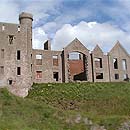
Slains Castle
Slains Castle, also known as New Slains Castle to distinguish it from nearby Old Slains Castle, is a ruined castle on the rocky Aberdeenshire coastline, near the town of Cruden Bay. This atmospheric ruined castle was originally built to replace Old Slains Castle, situated about six miles south-west of the present site, after it was destroyed in 1594. New Slains Castle was erected in 1597 on the site of the former Bowness Castle. It is often said that the Slains gave Bram Stoker the inspiration for Count Dracula’s castle while staying at nearby Cruden Bay in 1895.
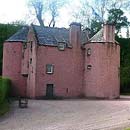
Terpersie Castle
Terpersie Castle is a 16th-century tower house in Tullynessle, Aberdeenshire, Scotland, located 5 kilometres (3.1 mi) north-west of Alford. Originally built in 1561, this castle burned down in 1665 and was then rebuilt. By 1885 it was a ruin, but was restored between 1983 and 1989 and is now a private home.

Towie Castle
Parish Hall, 1845-50. Sizeable hall, which began life as Oddfellows Hall, has square windows and wooden mullions. It occupies part of the site of Towie Castle, a ruined three-storey, L-plan Forbes mansion of the early 17th century, which had prettily corbelled angle turrets on its tall walls. Demolished 1968; plaque by Alford Academy pupils (Sandy Braso, art teacher) on small cairn beyond hall.

Towie Barclay Castle
Towie Barclay Castle is a historic castle in Aberdeenshire, Scotland, 4.5 miles south-south-east of Turriff. The current structure was built in 1593 by Clan Barclay. The site was given to the Clan in the 11th century by Malcolm III of Scotland.
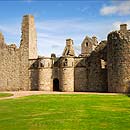
Tolquhon Castle
Tolquhon Castle. Noted for its highly ornamented gatehouse, Tolquhon is one of the most picturesque of the castles in the Grampian countryside. It lies about 1.5 miles north-west of Pitmedden, and 2 miles south of Tarves.

Udny Castle
Udny Castle is a tower house in the parish of Udny, southwest of the village of Pitmedden and northeast of the hamlet of Udny Green The castle was built by the Udny family in the 15th century and is still the home of family descendents. It is a five-storey harled rectangular tower house with ornamental turrets and walls 8 feet thick. The Udny family moved to their other property of Knockhall Castle, but after Knockhall burned down 100 years later in 1734, they returned to Udny Castle.

Westhall Castle
Westhall Castle, also known as Westhall House, is a country house located to the north of Oyne, in Aberdeenshire, Scotland. The house includes a 16th-century L-plan tower house, which was substantially extended in the 17th and 19th century.
